
The genus Pritchardia consists of between 24 and 40 species of fan palms found on tropical Pacific Ocean islands in Fiji, Samoa, Tonga, Tuamotus, and most diversely in Hawaii. The generic name honors William Thomas Pritchard (1829-1907), a British consul at Fiji.

Fulaga is a crescent-shaped reef-limestone island in Fiji's Southern Lau Group.
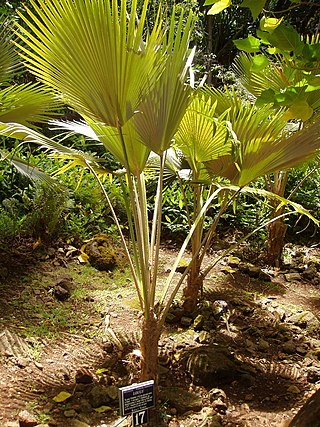
Pritchardia limahuliensis, the Limahuli Valley pritchardia, is a palm native to Hawaii. It is a rare species, only discovered in 1977 by staff of the National Tropical Botanical Garden in the Limahuli Garden and Preserve, Kauai, Hawaii, where it is now being conserved. It is threatened by introduced rats, which eat the seeds.

Sir John Bates Thurston was a British colonial official who served Fiji in a variety of capacities, including Premier of the Kingdom of Viti and later as colonial Governor.
Physokentia thurstonii is a species of flowering plant in the family Arecaceae. It is found only in Fiji. It is threatened by habitat loss.
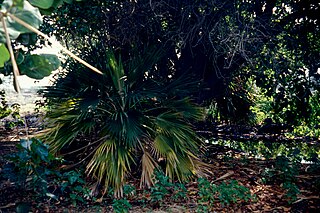
Pritchardia affinis, the Hawai'i pritchardia, is a species of palm tree that is endemic to the Hawaiian Islands. Wild populations currently exist on the leeward side of the Island of Hawaiʻi. It was most likely cultivated by Native Hawaiians, so its exact native range is uncertain. P. affinis reaches a height of 10–25 m (33–82 ft). It is threatened by rats and pigs, which damage the trees and eat the seeds before they can grow. It is a federally listed endangered species of the United States. Its fruit was reportedly the preferred food of the now-extinct ula-ai-hawane—a niche that has been seemingly filled by the introduced lavender waxbill.
Pritchardia aylmer-robinsonii is a species of palm tree that is endemic to the island of Niʻihau, Hawaii, United States. It inhabits coastal dry forests at an elevation of 70–270 m (230–890 ft). P. aylmer-robinsonii reaches a height of 7–15 m (23–49 ft) and a trunk diameter of 20–30 cm (7.9–11.8 in). Harold St. John discovered this species in 1949, and the specific epithet refers to Aylmer Francis Robinson, a member of the family that owned the island. P. aylmer-robinsonii has been reintroduced to the Makauwahi Cave Reserve on Kauaʻi, where the species is believed to have previously ranged.

Pritchardia kaalae, also known as Waianae Range pritchardia or loulu palm, is a species of palm tree that is endemic to the western part of the island of Oʻahu in Hawaiʻi. It grows near springs in the dry forests on the Waiʻanae Range at elevations up to 2,500 feet (760 m). This slow growing species reaches a height of 25 feet (7.6 m), with a trunk diameter of 1 foot (0.30 m). In 1998 there were fewer than 130 individuals remaining in the wild. This has been a federally listed endangered species of the United States since 1996.
Pritchardia lanaiensis, the Lānaʻi pritchardia, is a species of fan palm that is endemic to Hawaii in the United States. It can only be found on the island of Lānaʻi.
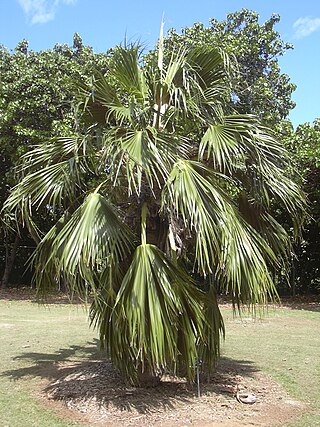
Pritchardia munroi, the Kamalo pritchardia, is a species of fan palm that is endemic to Hawaii in the United States. It is found in dry forests on the eastern (leeward) side of the island of Molokaʻi. The specific epithet, refers to James Monro, the manager of the Molokai Ranch at the time of its discovery (1920). Only two individuals exist in the wild, and both are at an elevation of 610 m (2,000 ft). It reaches a height of 4–5 m (13–16 ft) and a trunk diameter of 20 cm (7.9 in).
Pritchardia perlmanii, the Waiʻoli Valley pritchardia, is a species of palm tree that is endemic to the island of Kauaʻi in Hawaii, United States. It inhabits lowland mesic forests in the Waiʻoli Valley at an elevation of 420–850 m (1,380–2,790 ft). P. perlmanii reaches a height of 10 m (33 ft) and a trunk diameter of 30 cm (12 in).
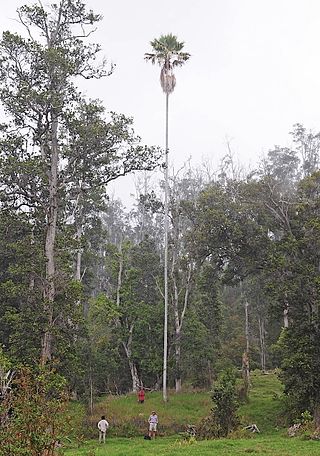
Pritchardia schattaueri, the lands of papa pritchardia or Schattauer's loulu, is a species of palm tree in the genus Pritchardia that is endemic to mixed mesic forests on the southwestern part of island of Hawaiʻi, near Kona. It is officially listed as a Critically endangered species.
Pritchardia waialealeana, the poleline pritchardia, is a species of palm tree that is endemic to the island of Kauaʻi in Hawaii, United States. It inhabits wet forests on the slopes of Mount Waiʻaleʻale at elevations of 500–700 m (1,600–2,300 ft). P. waialealeana, is a large palm, reaching a height of more than 20 m (66 ft).

The Fiji shrikebill is a songbird species in the family Monarchidae. It is found in American Samoa, Fiji, and Tonga. Its natural habitat is subtropical or tropical moist lowland forests.
The Ogea monarch or versicolored monarch is a species of bird in the family Monarchidae. It is endemic to two islands, Ogea Driki and Ogea Levu, in the Lau Group of south eastern Fiji.
Tabernaemontana thurstonii is a species of plant in the family Apocynaceae. It is endemic to Fiji.

The Makaleha Mountains are a mountain range in Kauai County on the eastern side of the Hawaiian island of Kauai. The highest point is approximately 3,215 feet above sea level.
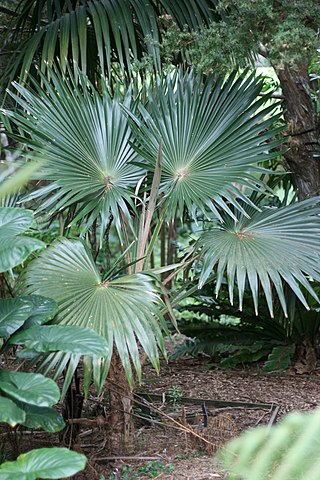
Pritchardia minor, the Alakai Swamp pritchardia or loulu, is a palm native to Hawaiʻi. It grows in wet forests in the centre of Kauaʻi at an elevation of about 1,400 metres (4,600 ft).
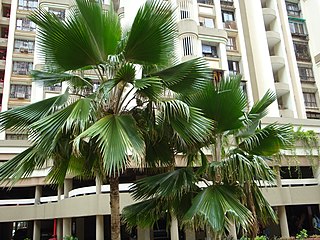
Pritchardia pacifica, the Fiji fan palm, or piu, is a species of palm tree in the genus Pritchardia that is native to Tonga. It is also found in Fiji, Samoa, and the north-eastern part of India, and the Marquesas. However, these populations are likely to be human introductions.

Pritchardia beccariana, the Kilauea pritchardia, or Beccari's loulu, is a species of palm tree in the genus Pritchardia that is endemic to wet forests on the eastern part of the island of Hawaiʻi, near Hilo.
















